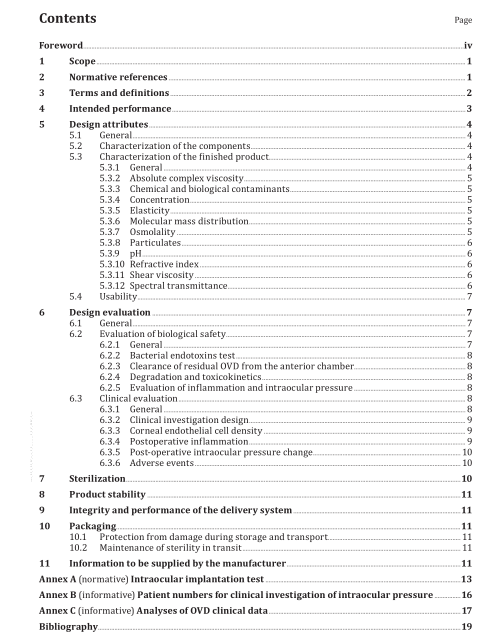ISO 15798:2022 pdf download.Ophthalmic implants — Ophthalmic viscosurgical devices
4 Intended performance
OVDs are surgically invasive medical devices. They shall be compatible with the internal ocular environment. Intended performance is primarily provided for by their viscous and/or viscoelastic properties, which are designed to create and maintain space, to protect intraocular tissues and to manipulate tissues during surgery in the anterior segment of the human eye. OVDs are used intraoperatively and intended to be removed at the end of surgery. The manufacturer shall describe any performance characteristic to be provided for by the OVD. In addition, the manufacturer shall particularly describe the intended way of application, the performance in protecting the corneal endothelium, the intended time that the OVD resides in the anterior chamber of the eye, and the method for removal. This method shall enable removal of the OVD as completely as possible.
In addition, the manufacturer shall describe and document the functional characteristics of the OVD in terms of its:
a) chemical composition;
b) rheological properties.
5 Design attributes
5.1 General
The following subclauses are listing specific design attributes to be met for the intended performance. Tests described therein are intended to apply when qualifying materials but not necessarily apply as a routine quality assurance/control programme. A risk assessment shall be performed in accordance with ISO 14971. OVD design attributes shall be documented. Where any of the design attributes is not considered to be relevant, the reason shall be documented and justified.
5.2 Characterization of the components
The manufacturer shall provide a description of the rheologically active component(s). The manufacturer shall provide a description of each compound belonging to the rheologically active component(s). The raw materials used in the manufacture of the product shall be listed qualitatively, along with their quality specifications. These shall comply with recognized compendial standards wherever possible. If the rheologically active component or one of its compounds is derived from animal sources, the requirements of ISO 22442-1, ISO 22442-2, and ISO 22442-3 shall apply. If the rheologically active component is a synthetic polymer, the repeating subunits that comprise it shall be chemically identified and the linkages between them described. Any cross linking shall also be described. The purity of water used shall be water for injection.
5.3 Characterization of the finished product
5.3.1 General All testing requirements described in 5.3.2 to 5.3.12 shall be performed with the finished, sterilized product. The rheological and optical properties of OVDs are physical characteristics that determine their performance in ophthalmic surgery. It is therefore imperative that the physical properties of OVDs identified below are fully and accurately described. The rheological properties shall be measured under the conditions expected and relevant at the time of use and be reported.
5.3.2 Absolute complex viscosity
The logarithm of the absolute complex viscosity versus the logarithm of the oscillation frequency shall be graphed to simultaneously demonstrate the resistance to flow and deformation of the OVD formulation. At very low frequencies the absolute complex viscosity approaches the zero shear viscosity.
NOTE Complex viscosity are usually determined at frequencies between (0,01 to 100) Hz (s −1 ). For products of very high viscosity (>2 × 10 3 Pa·s), frequencies below 0,01 Hz will be required to show the zero shear viscosity.
5.3.3 Chemical and biological contaminants
All chemical or biological contaminants shall be identified, and their potential ocular hazard shall be determined by risk analysis. For raw materials of biological origin, these contaminants can include proteins, nucleic acids, viruses and other transmissible agents (unclassified pathogenic entities, prions and similar entities, or other biological materials).
Contaminants derived from the source materials or from the manufacturing process (including sterilization), e.g. cross-linking agents and antioxidants, shall be identified whenever possible, and their concentrations in the finished product shall be reported. Assessment of contaminants shall consider degradation characteristics of active component, including interactions with laser light, ultrasound energy, or other high energy sources likely to be used along with the OVD during surgery, and leachables/extractables from the primary container.
Contaminants shall be determined using standard analytical methods, when available, and all methods shall be described. Limits for identified contaminants shall be set and included. Testing for the biological effects of these contaminants during evaluation of biological safety is required, if the risk analysis deems it necessary. Droplets of silicone lubricant, derived from the syringe, are frequent contaminants, often misinterpreted as air bubbles or particulates. Contamination of the product from this source should be considered in the risk assessment.ISO 15798 pdf download.ISO 15798 pdf download
